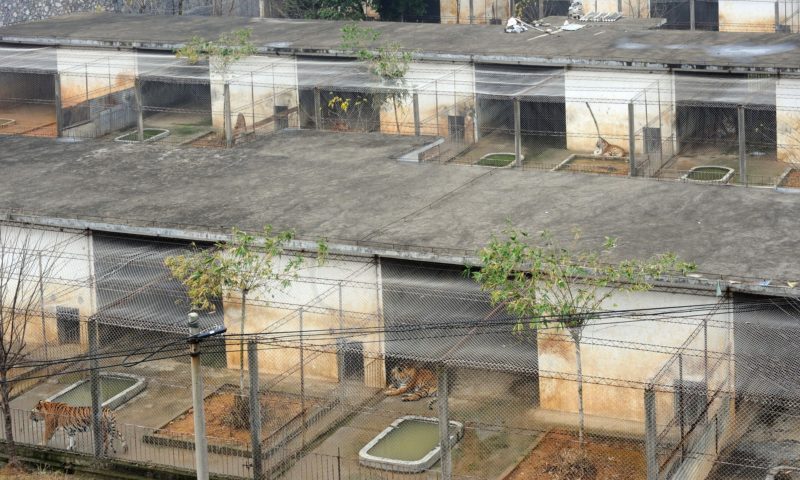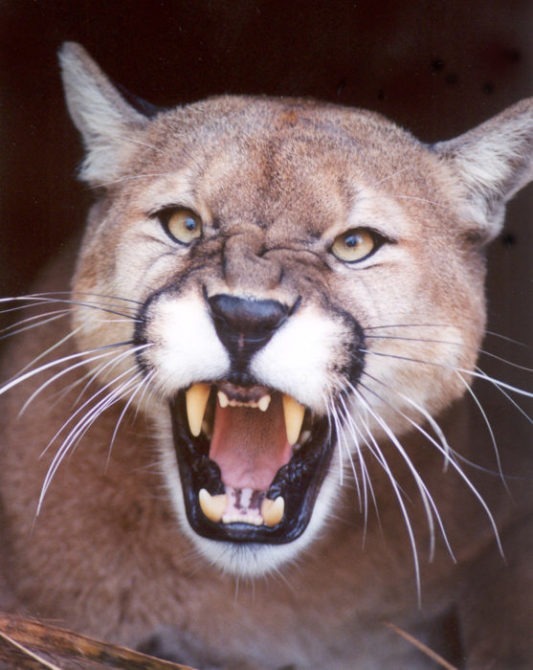Tiger Farms
What is a Tiger Farm?
A tiger farm is a breeding facility where tigers and other exotic or wild animals are bred like livestock for their meat, skin, and parts.
These farms often promote themselves as zoos or sanctuaries, working to conserve endangered species. In truth, they are exploiting tigers for profit – forcing them to perform in stage shows or take photos with tourists while alive and then slaughtering them for the luxury and medicinal markets once grown.
Farms spread across China, Laos, Vietnam and Thailand house between 7,000-8,000 captive tigers. To put that number in perspective – only 3,500 to 4,000 tigers are left in the wild.
While China’s wild tiger population is considered functionally extinct the country boasts the largest population of farmed tigers in Asia. A network of over 200 industrial farms reportedly has 5,000 to 6,000 tigers bred to supply the demand for tiger-bone wine, skins, taxidermy, and other products. Tiger skins are sold as luxury home décor while tiger bone wine, made by steeping tiger carcasses in vats of wine, is a symbol of wealth and status commonly gifted to business associates.
Tiger farming is making tiger poaching more lucrative. It is cheaper to kill wild tigers than it is to raise captive tigers, and consumers prefer products from the “real deal” (wild born tigers). Farming has normalized and legitimized the sale of tiger parts and products and has undermined global efforts to stamp out the illegal trade. There is no way to differentiate contraband from a wild born or captive born tiger. With so few wild tigers remaining, range countries should be focusing their efforts on conserving wild populations. Closing tiger farms and ending all trade in tiger parts and derivatives is the only way to eliminate demand for these products.

12 Reasons Why Tiger Farms Are Bad For Tigers
1. Tiger farms raise tigers for their parts. They are killed for their bones, meat, and pelts.
2. Tiger farming promotes the illegal trade. Farming tigers for trade increases market demand for their parts and fuels poaching of wild tigers throughout Asia. It will always be cheaper to kill a tiger in the wild than raise one in captivity.
3. Tigers on tiger farms tend to be obese and malnourished due to inappropriate diets and inadequate opportunities for natural behavior and exercise.
4. Tigers on tiger farms are kept in unnatural groups, often based on gender and age. In the wild, tigers are naturally solitary creatures.
5. Tigers on farms are not humanely euthanized. Rather, they are starved to death.
6. The tiger farming industry has absolutely no value for conservation. Tigers on tiger farms are inbred and crossbred from captive-born tigers. They cannot be released in the wild.
7. Tiger range countries with tiger farms are using funds to promote tiger farming instead of funding true and effective conservation programs that would benefit wild tiger populations.
8. Tiger farms serve as tourist attractions, where visitors are misled to believe that the cats are tame or domesticated and bred for conservation purposes.
9. Tiger farms also profit from cub petting pay-to-play schemes, where young cubs are taken from their mothers to be used as photos props.
10. Adult tigers are often de-clawed or de-fanged and made to perform in shows where trainers use abuse and intimidation to force the cats to act out unnatural behaviors and tricks.
11. Tiger farms are not just horrible for tigers they also breed other big cats for their parts, such as jaguars and lions. Livestock fair no better. As part of the attraction, tourists pay for the cheap thrill of throwing live chickens, lambs, cows, and other animals into the tiger pits to be torn apart. Because captive-born tigers do not know how to properly kill prey, these animals suffer long agonizing deaths.
12. Tigers may be housed in group pits or small metal and concrete cages, where they often stand in their own filth.

Did You Know?
Traditional Chinese Medicine (TCM) has not used tiger bones since 1993. The TCM community now rejects the use of tiger parts and promotes the use of alternatives.
Even though China is not the only country that has tiger farming, they continue to be the only country requesting that the Convention on International Trade in Endangered Species (CITES) lift its 2007 ban on tiger farming. China believes that the farms help reduce poaching of wild tiger populations – although studies have shown otherwise. An overwhelming majority of the countries to CITES adopted a decision in 2007 opposing any country from “farming tigers for the trade of their parts and derivatives.” The Chinese say their domestic market is not affected by the decision since CITES covers only international trade and, unfortunately, CITES has no way of enforcing the decision. In China domestic trade is legal and skins of captive-bred tigers can be traded as long as they have been bred legally, are processed by a licensed company, and come with a government-issued permit. The trade in parts and products of captive-bred tigers is illegal in Thailand, Laos, and Vietnam, although some question how well those laws are enforced.
JULY 29, 2018 Exclusive: Illegal Tiger Trade Fed by ‘Tiger Farms,’ New Evidence Reveals
OCTOBER 29, 2018 China Reverses Ban on Rhino and Tiger Parts in Medicine, Worrying Activists
NOVEMBER 12, 2018 China postpones lifting of ban on trade of tiger and rhino parts
There are more tigers privately owned in the United States than exist in the entire wild. An estimated 5,000 to 10,000 captive tigers live in the United States in backyards, roadside zoos, and private menageries. Most of these tigers are bred to support cub petting pay-to-play schemes. When they outgrow their use, these tigers end up traded as pets, caged for life, or sold for their parts (learn why interaction with big cat leads to illegal trafficking.) The U.S. is the second largest destination country for the illegal trade in goods made from endangered wildlife. Just like the farms in Asia, the private ownership of big cats in the U.S. promotes the illegal trade in tiger parts. However, unlike China, the U.S. does not track or manage the private ownership of tigers in the country. No one actually knows exactly how many big cats are kept in homes and backyards, leaving the U.S. government with no leg to stand on when demanding that China ends their trade. Help us end the private ownership of big cats in the U.S.
A disturbing reality behind that Chinese tiger drone video making the Internet rounds

What can you do about tiger farming?
In addition to not participating in cub petting and spreading awareness about the plight of captive and wild tigers, you can help to protect these amazing animals by supporting organizations that work to protect wild tiger populations. Read more about Big Cat Rescue’s work to support InSitu conservation projects.
Read more about Big Cat Rescue’s work to end tiger farming:
- Big Cat Rescue and the International Tiger Coalition
- Ending Tiger Trade film screening and discussion at CITES CoP17 in 2016
- 2009 CITES letter from the International Tiger Coalition
- BCR signs onto International letter to CITES to end tiger farming
More articles on Tiger Farming
https://www.thethirdpole.net/2017/06/07/chinas-tiger-farms-are-a-threat-to-the-species/





